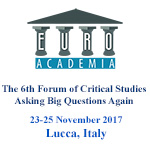Euroacademia Conferences
 Europe Inside-Out: Europe and Europeanness Exposed to Plural Observers (9th Edition) April 24 - 25, 2020
Europe Inside-Out: Europe and Europeanness Exposed to Plural Observers (9th Edition) April 24 - 25, 2020 Identities and Identifications: Politicized Uses of Collective Identities (9th Edition) June 12 - 13, 2020
Identities and Identifications: Politicized Uses of Collective Identities (9th Edition) June 12 - 13, 2020 8th Forum of Critical Studies: Asking Big Questions Again January 24 - 25, 2020
8th Forum of Critical Studies: Asking Big Questions Again January 24 - 25, 2020 Re-Inventing Eastern Europe (7th Edition) December 13 - 14, 2019
Re-Inventing Eastern Europe (7th Edition) December 13 - 14, 2019 The European Union and the Politicization of Europe (8th Edition) October 25 - 26, 2019
The European Union and the Politicization of Europe (8th Edition) October 25 - 26, 2019 Identities and Identifications: Politicized Uses of Collective Identities (8th Edition) June 28 - 29, 2019
Identities and Identifications: Politicized Uses of Collective Identities (8th Edition) June 28 - 29, 2019 The European Union and the Politicization of Europe (7th Edition) January 25 - 26, 2019
The European Union and the Politicization of Europe (7th Edition) January 25 - 26, 2019 7th Forum of Critical Studies: Asking Big Questions Again November 23 - 24, 2018
7th Forum of Critical Studies: Asking Big Questions Again November 23 - 24, 2018 Europe Inside-Out: Europe and Europeanness Exposed to Plural Observers (8th Edition) September 28 - 30, 2018
Europe Inside-Out: Europe and Europeanness Exposed to Plural Observers (8th Edition) September 28 - 30, 2018 Identities and Identifications: Politicized Uses of Collective Identities (7th Edition) June 14 - 15, 2018
Identities and Identifications: Politicized Uses of Collective Identities (7th Edition) June 14 - 15, 2018
Reviving Social Connectivity and Tradition in South Korea through Urban Development
-
-

-
Presentation speakers
- Seung Jin Choi , Independent Researcher
Abstract:
How can architectural transformation possibly incorporate the past and the future and effectively intervene in questions of contemporary urban social housing? This study takes a scholarly approach to urbanism in South Korea since the urban population rapidly increased in the late 20th century, when the demand for urban residences resulted in significant housing shortages. In this period of rapid urbanization, the idea of a hanok or madang merging modernism with vernacular forms was considered unsuited to the burgeoning population. This in turn prompted a sharp departure from Korean architectural tradition in favor of the production of massive numbers of apartments in the capital, with little thought to social implications. In the late twentieth century, Chung-Up Kim, a central figure in theories of Korean urbanism, revisited many of these issues, attempting to merge utopian modernist ideals of city planning from Le Corbusier with traditional culture. Kim designed and built numerous large projects for public and commercial commissions, initiating a regionalism that highlighted the traditional Korean roofline, a gesture subsequently much imitated among Korean architects. In the past century, the inflexibility of existing infrastructure brought limitations on renovating and restructuring, partly explaining the confinement of Kim’s work to non-dwelling houses and the difficulty not only of urban growth, but also of applying new considerations of social aspects to already existing apartments with significant populations. New town constructions in Gangnam District employing advanced engineering and skyrocketing towers consequently led to further architecturally inscribed disjunctions between social groups. Le Corbusier’s proposed standardization of architecture in harmony with the economic and social aspects of urban life thus raises new questions of how the Western modernist city could be integrated with Korean vernacular architecture to encourage interactions between neighbors without the concrete walls that segregate apartments from society at large.
-
Related Presentations

Metamorphoses in the City and the Place of Collective Memory: What Challenges?
- Joana Ribeiro Santos

Rethinking China’s Revolutionary Identity in Transformation: Memory, Reflection, and Cultural Politics
- Mengqian Yuan
- Chu-Jie Chen













